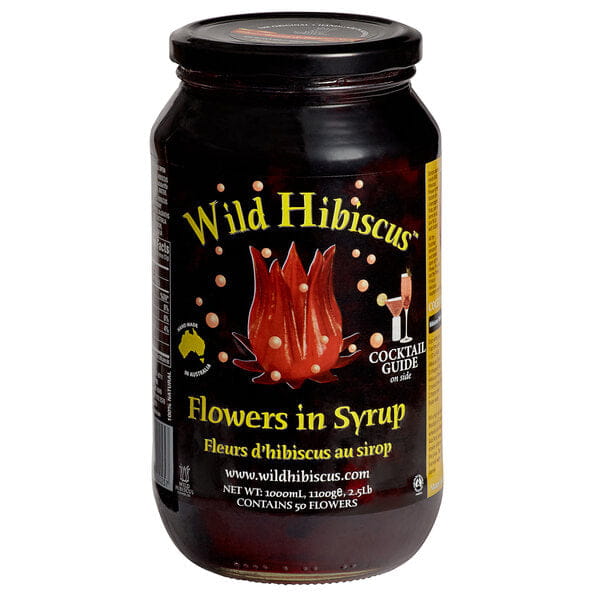Wild Hibiscus Flowers in Syrup: A Culinary Exploration
In the culinary world, the relentless pursuit of unique and vibrant flavors is an ongoing journey. One ingredient that has captured the attention of chefs and home cooks alike is the Wild Hibiscus Flowers in Syrup. This exquisite product offers a captivating blend of tartness and floral notes, adding a touch of elegance and sophistication to a wide array of dishes. Its versatility extends beyond simple aesthetics; it's a flavor powerhouse that adds depth and complexity to culinary creations, pushing the boundaries of traditional flavor profiles.

This in-depth article delves into the origins, flavor chemistry, and gourmet potential of these remarkable flowers, showcasing their versatility in both sweet and savory applications, and providing practical tips and recipe inspiration for home cooks and professional chefs alike.
A Journey from Flower to Syrup: The Art of Preservation
The journey of wild hibiscus flowers in syrup begins long before they arrive in your kitchen. It starts with the careful selection and harvesting of the hibiscus blossoms, a process that demands attention to detail to ensure the flowers retain their vibrant color and delicate flavor. The timing of the harvest is crucial, as it directly impacts the concentration of flavor compounds within the petals. Only blossoms at their peak ripeness are chosen, ensuring a superior final product.
Following harvest, the flowers undergo a meticulous preservation process. This involves steeping the blossoms in a carefully formulated sugar syrup, a technique that gently locks in the natural tartness and subtle floral notes. The sugar syrup acts not only as a preservative but also as a flavor enhancer, balancing the inherent tartness of the hibiscus with a delicate sweetness. The precise balance of sugar and water in the syrup is critical to achieving the perfect harmony of flavors. The result is a product that is both aesthetically pleasing and bursting with a complex and nuanced flavor profile.
Unveiling the Flavor Chemistry: A Symphony of Acids and Aromatics
The distinctive flavor of wild hibiscus flowers in syrup isn't simply a matter of chance; it's a result of the complex interplay of organic acids and aromatic compounds present in the hibiscus blossoms. The tartness is primarily attributed to the presence of malic acid and citric acid, two organic acids commonly found in fruits and vegetables. These acids contribute to the refreshing, slightly tangy character that is a hallmark of hibiscus flavor.
However, the flavor profile extends beyond simple tartness. A variety of volatile aromatic compounds contribute to the subtle floral notes that add depth and complexity to the overall taste experience. These compounds, often present in small concentrations, interact synergistically to create a unique and nuanced flavor profile that's both familiar and unexpected. The delicate balance between the tartness of the acids and the floral notes of the aromatic compounds is what makes the wild hibiscus flowers in syrup so captivating.
Gourmet Applications: Unleashing the Potential of a Versatile Ingredient
The versatility of wild hibiscus flowers in syrup is truly remarkable. Their vibrant color and unique flavor make them ideal for enhancing both sweet and savory dishes, transcending traditional culinary boundaries. Their applications are as diverse as the imaginations of the chefs who utilize them.
In the realm of desserts, their tartness adds a delightful contrast to sweetness, balancing rich chocolate desserts, enhancing fruit-based pastries, and adding a touch of elegance to simple panna cotta. Their vibrant color provides a stunning visual appeal, transforming ordinary desserts into works of art.
In savory cuisine, the possibilities are equally expansive. Their tartness cuts through richness, making them a perfect addition to marinades for grilled meats, sauces for poultry, and garnishes for salads. They add a depth of flavor that elevates even the simplest dishes.
Mixology also benefits from the versatility of wild hibiscus flowers in syrup. Their vibrant color and tartness make them an ideal ingredient for creating sophisticated cocktails, adding a unique twist to classic recipes and inspiring entirely new creations. They pair beautifully with champagne, tequila-based cocktails, and other spirits, adding a touch of elegance and complexity.
- Garnishes: Elevate cocktails, desserts, and savory plates with their vibrant color and delicate texture.
- Flavor Enhancers: Infuse syrups, sauces, and marinades with their tart and floral notes, adding depth and complexity.
- Cocktail Ingredients: Create unique and refreshing cocktails with a beautiful color and complex flavor profile.
- Dessert Components: Incorporate them into pastries, jams, and other desserts for an unexpected twist, adding both visual appeal and a delightful tartness.
- Salad Additions: Add a pop of color and a unique tartness to salads, complementing both fruit and savory ingredients.
Beyond the Plate: Nutritional Benefits and Culinary Considerations
Beyond their culinary applications, wild hibiscus flowers in syrup also offer potential nutritional benefits. Hibiscus is known to be rich in antioxidants, contributing to overall health and well-being. While the syrup adds sweetness, the inherent properties of the hibiscus flowers remain preserved, adding a healthful dimension to this versatile ingredient.
When using wild hibiscus flowers in syrup, it's important to store them properly to maintain their vibrant color and flavor. Keep them in a cool, dark place, away from direct sunlight and heat. Handle them gently to preserve their delicate structure. Remember, these are not just ingredients; they are a culinary experience.
Conclusion: Embracing the Culinary Potential
In conclusion, wild hibiscus flowers in syrup represent a remarkable culinary discovery. Their unique flavor profile, vibrant color, and versatility make them a prized ingredient for both professional chefs and home cooks seeking to add a touch of elegance and sophistication to their creations. Their ability to enhance both sweet and savory dishes, as well as their potential in mixology, makes them a truly versatile and exciting ingredient. So, why not explore the boundless potential of this remarkable ingredient and elevate your culinary experiences?

